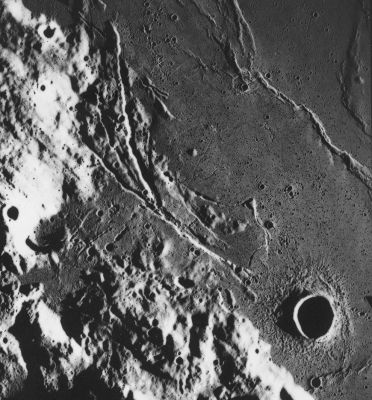Sulpicius Gallus
Contents
- 1 Sulpicius Gallus
- 1.1 Images
- 1.2 Sunrise at the curious vent immediately west of Sulpicius Gallus, as photographed by the Fairchild camera aboard the SIM-bay of Apollo 17's CSM America
- 1.3 Maps
- 1.4 Description
- 1.5 Description: Elger
- 1.6 Description: Wikipedia
- 1.7 Additional Information
- 1.8 Lunar Ellipse of Fire
- 1.9 Nomenclature
- 1.10 LPOD Articles
- 1.11 Lunar 100
- 1.12 Bibliography
Sulpicius Gallus
|
Lat: 19.6°N, Long: 11.6°E, Diam: 12 km, Depth: 2.33 km, Rükl: 23, Copernican |

Apollo 17 image AS17-M-0809 Sulpicius Gallus is the shadowed crater at lower right. The forked system of rilles extending to the northwest is Rimae Sulpicius Gallus. The highland areas, especially at lower left, are part of Montes Haemus. The sharp ridge cutting diagonally across the image in the upper right is Dorsum Buckland. The broader vertical ridge to its upper right (paralleling the image margin) may be part of Dorsum Von Cotta.
Images
LPOD Photo Gallery Lunar Orbiter Images Apollo Images ASU Apollo Image Archive
See also the LPI's Sulpicius Gallus, west of and AS15-81-10957 (the curious vent immediately west of Sulpicius Gallus).- DannyCaes Feb 16, 2012
Sunrise at the curious vent immediately west of Sulpicius Gallus, as photographed by the Fairchild camera aboard the SIM-bay of Apollo 17's CSM America
(in each one of the photographs, the curious oval-shaped vent is almost always noticeable near the very centre of the frame)
- AS17-M-0808
- AS17-M-1233
- AS17-M-1514
- AS17-M-1817
- AS17-M-2264 (in this photograph, the curious vent is noticeable near the central part of the frame's left margin)
- AS17-M-2422 (in this oblique southward-looking photograph, the curious vent is noticeable rightward of the frame's centre)
- AS17-M-2700 (in this photograph, the curious vent is noticeable slightly above and to the left of the frame's centre)
- AS17-M-2894
Research: Danny Caes
Maps
(LAC zone 42D4) LAC map Geologic map LM map LTO map
IAU page: Sulpicius Gallus
Description
Description: Elger
(IAU Directions) SULPICIUS GALLUS.--Another brilliant object on the south edge of the Mare Serenitatis, some distance W. of Menelaus. It is a deep circular crater about 8 miles in diameter, rising to a considerable height above the surface. Its shadow under a low morning sun is prominently jagged. On the W. are two bright mounds, and S. of that which is nearer the border of the Mare, commences a cleft which, following the curvature of the coast- line, terminates at a point in E. long. 9 deg. This object varies considerably in width and depth. Another shorter and coarser cleft runs S. of this across an irregularly shaped bay or inflexion in the border of the Mare.
Description: Wikipedia
Additional Information
- Depth data from Kurt Fisher database
- Elachi, 1976: 2.33 km
- Pike, 1976: 2.17 km
- Arthur, 1974: 2.16 km
- Westfall, 2000: 2.17 km
- Viscardy, 1985: 2.2 km
- Sulpicius Gallus, Sulpicius Gallus M, and a small crater to the NW of Sulpicius Gallus are thermal anomaly craters, implying youthful ages - Moore et al, 1980
- During the mission of Apollo 17 in December 1972, the orbiting astronauts noticed orange-red (and brick-red) colored spots near Sulpicius Gallus. See: Sulpicius Gallus Formation: a splash of color.
- An area near Sulpicius Gallus has been designated a Constellation Region of Interest.
Lunar Ellipse of Fire
Sulpicius Gallus is (or was?) number two in the list of 12 localities in the Lunar Ellipse of Fire (see article from Farouk El-Baz in Sky and Telescope - June 1973).
Nomenclature
- Named for Gaius Sulpicius Gallus (unkn-fl. c. B.C. 166) a Roman general, statesman and orator. Gallus was a man of great learning, an excellent Greek scholar, and in his later years devoted himself to the study of astronomy, on which subject he is quoted as an authority by Pliny.
- The name Sulpicius Gallus was introduced into the lunar nomenclature by Riccioli, although Whitaker (page 215) feels the feature designated by Riccioli was the bright spot surrounding Sulpicius Gallus M.
- Beer and Mädler seem to have assumed Riccioli intended the name for the present crater, which was Catalog number 606 in Mary Blagg's Collated List. Her two later authorities also called it Sulpicius Gallus.
- The present name was part of the original IAU nomenclature of Named Lunar Formations.
- Sulpicius Gallus Alpha (pronounced section of Montes Haemus, southeast of Sulpicius Gallus) (see Chart 30 in the Times Atlas of the Moon).
LPOD Articles
Lunar 100
L71: Ash eruptions northwest of crater.
Bibliography
- Lucchitta, B. K. & H. H. Schmidt (1974) Orange material in the Sulpicius Gallus Formation at the southern edge of Mare Serenitatis. Proc. 5th Lunar Conf., 223-234.